 | |
| Use | Civil and war flag, naval ensign |
|---|---|
| Adopted | 29 July 1899 (Hague Convention I) |
White flags have had different meanings throughout history and depending on the locale.
 | |
| Use | Civil and war flag, naval ensign |
|---|---|
| Adopted | 29 July 1899 (Hague Convention I) |
White flags have had different meanings throughout history and depending on the locale.

The white flag is an internationally recognized protective sign of truce or ceasefire, and for negotiation. It is also used to symbolize surrender, since it is often the weaker party that requests negotiation. It is also flown on ships serving as cartels. A white flag signifies to all that an approaching negotiator is unarmed, with an intent to surrender or a desire to communicate. Persons carrying or waving a white flag are not to be fired upon, nor are they allowed to open fire. The use of the flag to request parley is included in the Hague Conventions of 1899 and 1907: [1]
CHAPTER III -- On Flags of Truce
Article 32
An individual is considered a parlementaire who is authorized by one of the belligerents to enter into communication with the other, and who carries a white flag. He has a right to inviolability, as well as the trumpeter, bugler, or drummer, the flag-bearer, and the interpreter who may accompany him.
— Hague Convention of 1899, Laws of War : Laws and Customs of War on Land (Hague II); July 29, 1899
Annex to the Convention, Section II, Chapter III, Article 32
The improper use of the flag is forbidden by the rules of war and constitutes a war crime of perfidy. There have been numerous reported cases of such behavior in conflicts, such as combatants using white flags as a ruse to approach and attack enemy combatants, or killings of combatants attempting to surrender by carrying white flags.
The first mention of the usage of white flags to surrender is made during the Eastern Han dynasty (AD 25–220). In the Roman Empire, the historian Cornelius Tacitus mentions a white flag of surrender in AD 109. Before that time, Roman armies would surrender by holding their shields above their heads. [2]
During the Middle Ages and in a political environment centered on oaths, participating in another lord’s banner or standard signified changing allegiance and loyalty. Thus, armies would waive the banner of the opposite side to signal surrender.
The French Capetian dynasty utilized a prominent white banner during this period, referred to at the time as the oriflamme. [3] As head of House Capet, Philip II adopted a single white flag as the family's emblem, still closely identified with the Kings of France for several generations. “Its very name - a derivation of ‘golden flame’ - shows that it was intended from its inception to represent the French crown”. [4]
This meaning is affirmed a few years later during a subsequent conflict between the French monarchy and the English throne. At the siege of Fréteval castle in 1194, the English knights defending the castle “came clad in white tunics, barefoot, holding up white cloths” to King Philip and his invading army to indicate their surrender. [5] The color white, synonymous with the royal Capet flag, demonstrated the way medieval visual symbolism intertwined with feudal expressions of submission and dominance.
Through the 13th century, the precedent of utilizing white flags and banners to surrender to the French continued to proliferate after many French victories and across medieval Europe as Philip Augustus expanded the royal domain. Matthew Paris notes how during a 1231 rebellion against King Henry II of England in Wales, the princes pleading for mercy “came before him bearing the king’s white banner”. [6] This correlated the white flag with signaling transition of land or rulership.
Thus, the original meaning of waving a white flag was deeply tied to feudal custom, acknowledging and pledging loyalty or sanctuary to a specific lord and his noble standard. By the later Middle Ages, however, the distinct connection of the white symbol to House Capet and French royalty diminished as it gained wider currency as a gesture indicating any general surrender or truce between opposing armies regardless of feudal loyalties.
Through diffusion over time and across Europe, the white flag of the Capets, became divorced from a strict embodiment of Capetian suzerainty in war. Regardless of its shifting meaning, the basis of the tradition itself clearly originated in 12th century medieval France. [7] [8] [9] [10]
In renaissance white flag was widely used in Western Europe to indicate an intent to surrender. The color white was not used as the colors of the king of France anymore but instead to generally indicate a person was exempt from combat; heralds bore white wands, prisoners or hostages captured in battle would attach a piece of white paper to their hat or helmet, and garrisons that had surrendered and been promised safe passage would carry white batons. [11]

Its use may have expanded across continents, e.g. Portuguese chronicler Gaspar Correia (writing in the 1550s), claims that in 1502, an Indian ruler, the Zamorin of Calicut, dispatched negotiators bearing a "white cloth tied to a stick", "as a sign of peace", to his enemy Vasco da Gama. [12] In 1625, Hugo Grotius in De jure belli ac pacis (On the Law of War and Peace), one of the foundational texts in international law, recognized the white flag as a "sign, to which use has given a signification"; it was "a tacit sign of demanding a parley, and shall be as obligatory, as if expressed by words". [13]
The Umayyad dynasty (661–750) used white as their symbolic color as a reminder of Muhammad's first battle at Badr.
The Alids and the Fatimid dynasty also used white in opposition to the Abbasids, who used black as their dynastic color. [14] [15]
During the period of the Ancien Régime, starting in the early 17th century, the royal standard of France became a plain white flag as a symbol of purity, sometimes covered in fleur-de-lis when in the presence of the king or bearing the ensigns of the Order of the Holy Spirit.[ citation needed ]
The white color was also used as a symbol of military command, by the commanding officer of a French army. It would be featured on a white scarf attached to the regimental flag as to recognize French units from foreign ones and avoid friendly fire incidents. The French troops fighting in the American Revolutionary War fought under the white flag.
The French Navy used a plain white ensign for ships of the line. Smaller ships might have used other standards, such as a fleur-de-lis on white field. Commerce and private ships were authorized to use their own designs to represent France, but were forbidden to fly the white ensign.
During the French Revolution, in 1794, the blue, white and red Tricolore was adopted as the official national flag. The white flag quickly became a symbol of French royalists. (The white part of the French Tricolor is itself originally derived from the old Royal flag, the tricolor having been designed when the revolution still aimed at constitutional monarchy rather than a republic; this aspect of the Tricolor was, however, soon forgotten.)[ citation needed ]
During the Bourbon Restoration, the white flag replaced the Tricolore, which by then was seen as a symbol of regicide.
It was finally abandoned in 1830, with the July Revolution, with the definitive use of the blue, white and red flag.
In 1873, an attempt to reestablish the monarchy failed when Henri of Artois, the Count of Chambord refused to accept the Tricolore. He demanded the return of the white flag before he would accept the throne, a condition that proved unacceptable.
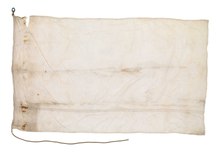
In 1929, members of the British Australian and New Zealand Antarctic Research Expedition on RRS Discovery used white cotton sheeting to improvise a courtesy ensign (a flag used as a token of respect by vessels while in foreign waters) for a continent without a flag of its own. It is now in the National Maritime Museum in London. The white flag was used to represent Antarctica on at least two occasions on the voyage to Antarctica. On 1 August 1929, The Times noted that "the ship was flying the Union Jack at her forepeak, the white Antarctic flag at the foremast, and the Australian flag at the stern." [16] [17]
The white flag was the official flag of the Taliban-ruled Islamic Emirate of Afghanistan between September 1996 and October 1997. [18] It is sometimes used as an unofficial variant of the current flag which includes the Shahada written in black on a white field.

A national flag is a flag that represents and symbolizes a given nation. It is flown by the government of that nation, but can also be flown by its citizens. A national flag is typically designed with specific meanings for its colours and symbols, which may also be used separately from the flag as a symbol of the nation. The design of a national flag is sometimes altered after the occurrence of important historical events. The burning or destruction of a national flag is a greatly symbolic act.
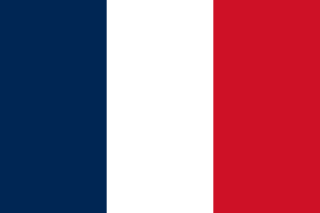
The national flag of France is a tricolour featuring three vertical bands coloured blue, white, and red. It is known to English speakers as the Tricolour, although the flag of Ireland and others are also so known. The design was adopted after the French Revolution, where the revolutionaries were influenced by the horizontally striped red-white-blue flag of the Netherlands. While not the first tricolour, it became one of the most influential flags in history. The tricolour scheme was later adopted by many other nations in Europe and elsewhere, and, according to the Encyclopædia Britannica has historically stood "in symbolic opposition to the autocratic and clericalist royal standards of the past".
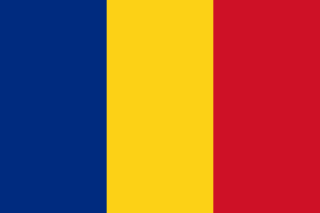
The national flag of Romania is a tricolour. The Constitution of Romania states that "The flag of Romania is tricolour; the colours are arranged vertically in the following order from the flagpole: blue, yellow, red". The flag has a width-length ratio of 2:3; the proportions, shades of colour as well as the flag protocol were established by law in 1994, and extended in 2001.
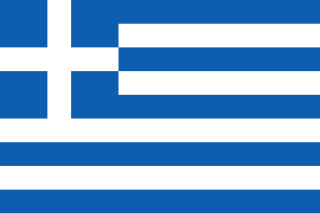
The national flag of Greece, popularly referred to as the "turquoise and white one" or the "azure and white", is officially recognised by Greece as one of its national symbols and has 5 equal horizontal stripes of blue alternating with white. There is a blue canton in the upper hoist-side corner bearing a white cross; the cross symbolises Eastern Orthodox Christianity. The blazon of the flag is Azure, four bars Argent; on a canton of the field a Greek cross throughout of the second. The official flag ratio is 2:3. The shade of blue used in the flag has varied throughout its history, from light blue to dark blue, the latter being increasingly used since the late 1960s. It was officially adopted by the First National Assembly at Epidaurus on 13 January 1822.
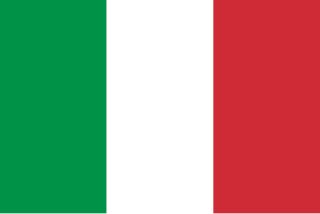
The national flag of Italy, often referred to in Italian as il Tricolore, is a tricolour featuring three equally sized vertical pales of green, white and red, national colours of Italy, with the green at the hoist side, as defined by article 12 of the Constitution of the Italian Republic. The Italian law regulates its use and display, protecting its defense and providing for the crime of insulting it; it also prescribes its teaching in Italian schools together with other national symbols of Italy.

In politics, a red flag is predominantly a symbol of left-wing politics, including socialism, communism, Marxism, labour movement, and anarchism. The originally empty or plain red flag has been associated with left-wing politics since the French Revolution (1789–1799).

The national flag of the Islamic Emirate of Afghanistan, adopted on 15 August 2021 following the Taliban's victory in the 2001–2021 war, features a white field with a black Shahada inscribed. Since the 20th century, Afghanistan has changed its national flag several times. The national flag had black, red and green colors most of the time during the period.
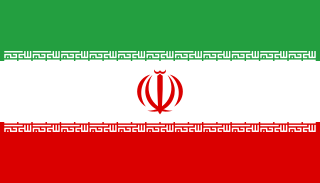
The national flag of the Islamic Republic of Iran, also known as the tricolor, is a tricolor featuring the Pan-Iranian colors comprising equal horizontal bands of green, white and red with the national emblem ("Allah") in red centred on the white band and the takbir written 11 times each in the Kufic script in white, at the bottom of the green and the top of the red band. After the Iranian Revolution of 1979, the present-day flag was adopted on 29 July 1980.
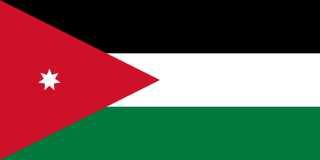
The flag of Jordan, officially adopted on 16 April 1928, is based on the 1916 flag of the Arab Revolt against the Ottoman Empire during World War I. The flag consists of horizontal black, white, and green bands that are connected by a red chevron. The colours are the Pan-Arab Colors, respectively representing the Abbasid, Umayyad, and Fatimid or Rashidun caliphates. The red chevron is for the Hashemite dynasty, and the Arab Revolt.
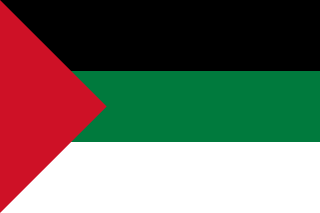
The Pan-Arab colors are black, white, green and red. Individually, each of the four Pan-Arab colors were intended to represent a certain aspect of the Arabs and their history.

The Black Banner or Black Standard (Arabic: الراية السوداء, romanized: ar-rāyat as-sawdāʾ, also known as راية العقاب is one of the flags flown by the Islamic prophet Muhammad according to Muslim tradition. It was historically used by Abu Muslim in his uprising leading to the Abbasid Revolution in 747 and is therefore associated with the Abbasid Caliphate in particular. It is also a symbol in Islamic eschatology though this tradition is weak according to hadithic standards.

An Islamic flag is the flag either representing an Islamic Caliphate or religious order, state, civil society, military force or other entity associated with Islam. Islamic flags have a distinct history due to the Islamic prescription on aniconism, making particular colours, inscriptions or symbols such as crescent-and-star popular choices. Since the time of the Islamic prophet Muhammad, flags with certain colours were associated with Islam according to the traditions. Since then, historical Caliphates, modern nation states, certain denominations as well as religious movements have adopted flags to symbolize their Islamic identity.

New England has no official flag. However, there have been many historical or modern banners used to represent the region in its history. While there are some variations, common designs include a plain colored field with a pine tree in the canton. The eastern white pine is the most common and prominent symbol of New England and is featured on many of the region's flags.

The flag of the Arab Revolt, also known as the flag of Hejaz, was a flag used by Hussein bin Ali and his allies, the Arab nationalists, during the Arab Revolt against the Ottoman Empire during World War I, and as the first flag of the Kingdom of Hejaz. It was designed by Mark Sykes but is highly reminiscent of previous Arab flags, such as the flags of the al-Muntada al-Adabi, al-ʽAhd and al-Fatat.

The flag of the Qing dynasty was an emblem adopted in the late 19th century featuring the Azure Dragon on a plain yellow field with the red flaming pearl in the upper left corner. It became the first national flag of China and is usually referred to as the "Yellow Dragon Flag".

The cockade of France is the national ornament of France, obtained by circularly pleating a blue, white and red ribbon. It is composed of the three colors of the French flag, with blue in the center, white immediately outside and red on the edge.

During its existence, Austria-Hungary did not have a common flag – a "national flag" could not exist since the Dual Monarchy consisted of two sovereign states. However, the black-gold flag of the ruling Habsburg Dynasty was sometimes used as a de facto national flag and a common civil ensign was introduced in 1869 for civilian vessels. Until 1918, the k.u.k. War Fleet continued to carry the Austrian ensign it had used since 1786 and the regiments of the k.u.k. Army carried the double-eagle banners they had used before 1867, as they had a long history in many cases. New ensigns created in 1915 were not implemented due to the ongoing war. At state functions, the Austrian black-yellow and the Hungarian red-white-green tricolor were used.
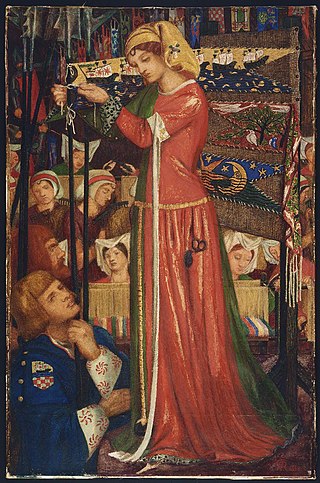
A flag is a distinctive piece of fabric used as a symbol, a signalling device, or for decoration. While the origin of flags is unknown, flag-like symbols have been described as far back as 11th century BC China and have been used by other ancient civilisations such as Egypt and Rome.
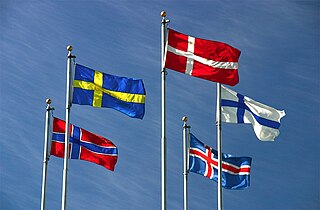
Flag families are sets of national flags with similarities in their design, often based on a shared history, culture, or influence. Families do not include flags with coincidental similarities. Flags may be in multiple flag families. Only twelve current national flags existed before the 19th century, when large-scale flag use began. Seven of these flags are the inspiration for more than 130 current national flags and ensigns.
mandou hum seu Bramane em huma almadia com hum pano branco atado e um páu per sinal de paz
The Ismaili Shi'ite counter-caliphate founded by the Fatimids took white as its dynastic color, creating a visual contrast to the Abbasid enemy.
...white was also the color associated with the Fatimid caliphs, the opponents of the Abbasids.
the Afghan Taliban used a plain white flag between 1996 and 1997 and a white flag with the Islamic credo in black letters from 1997 on until today.